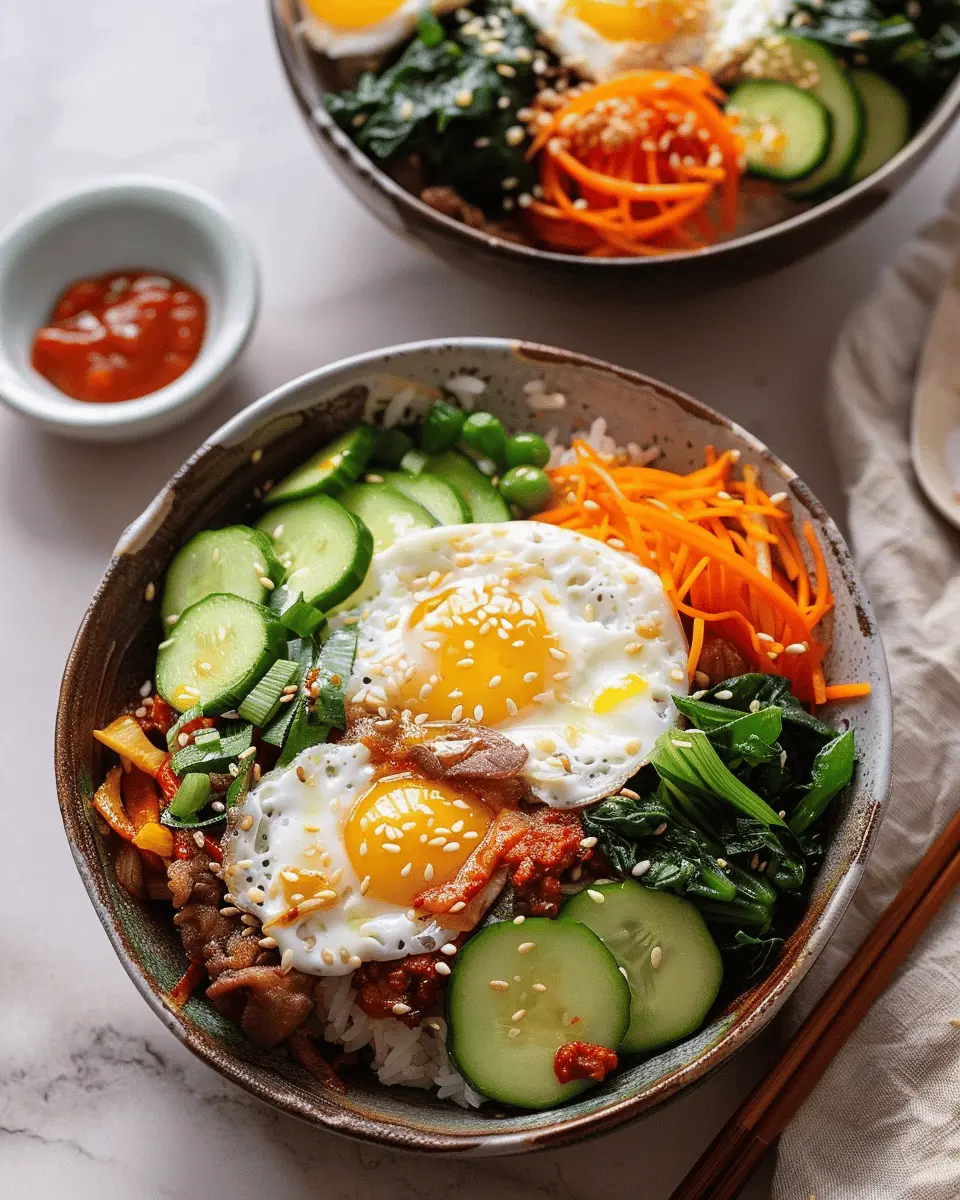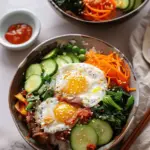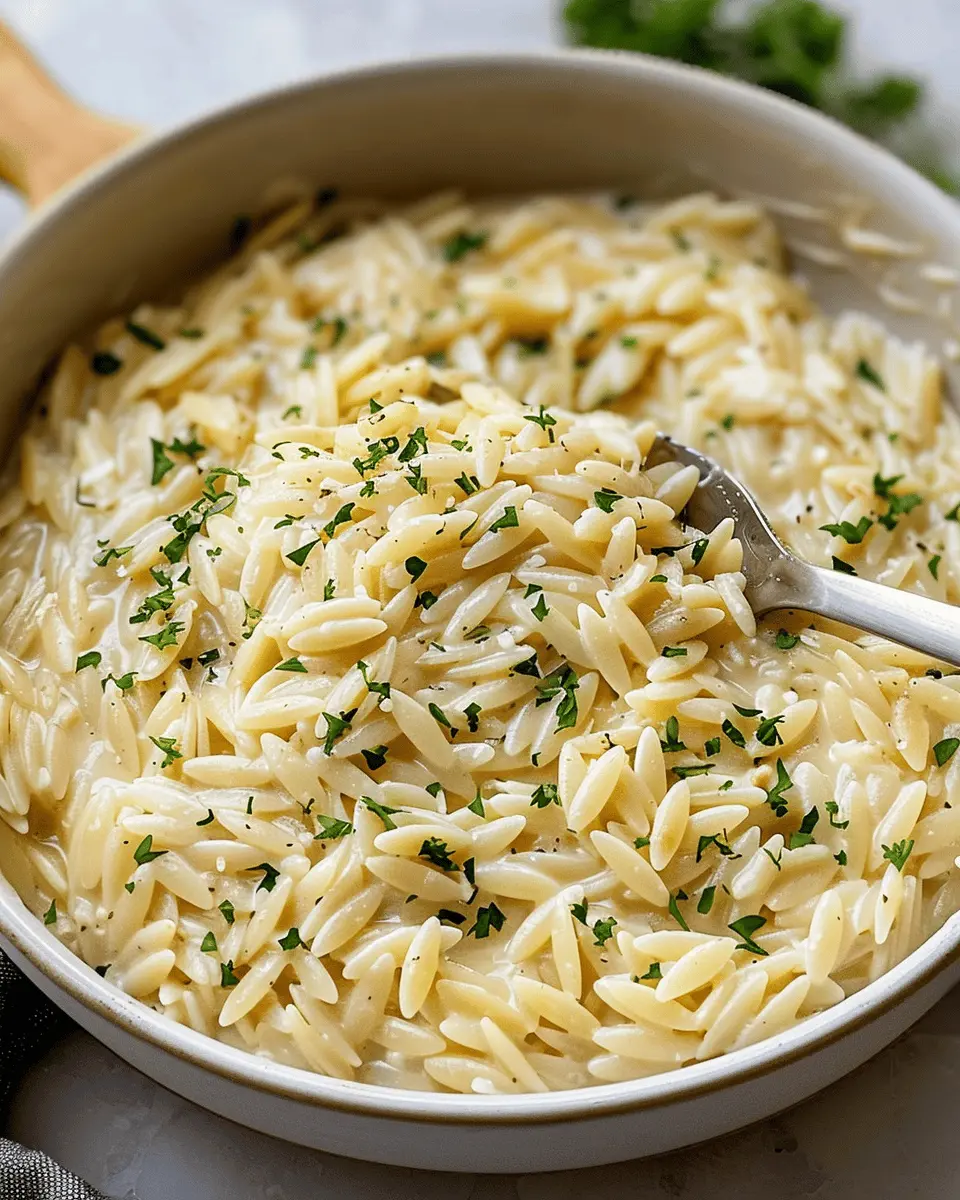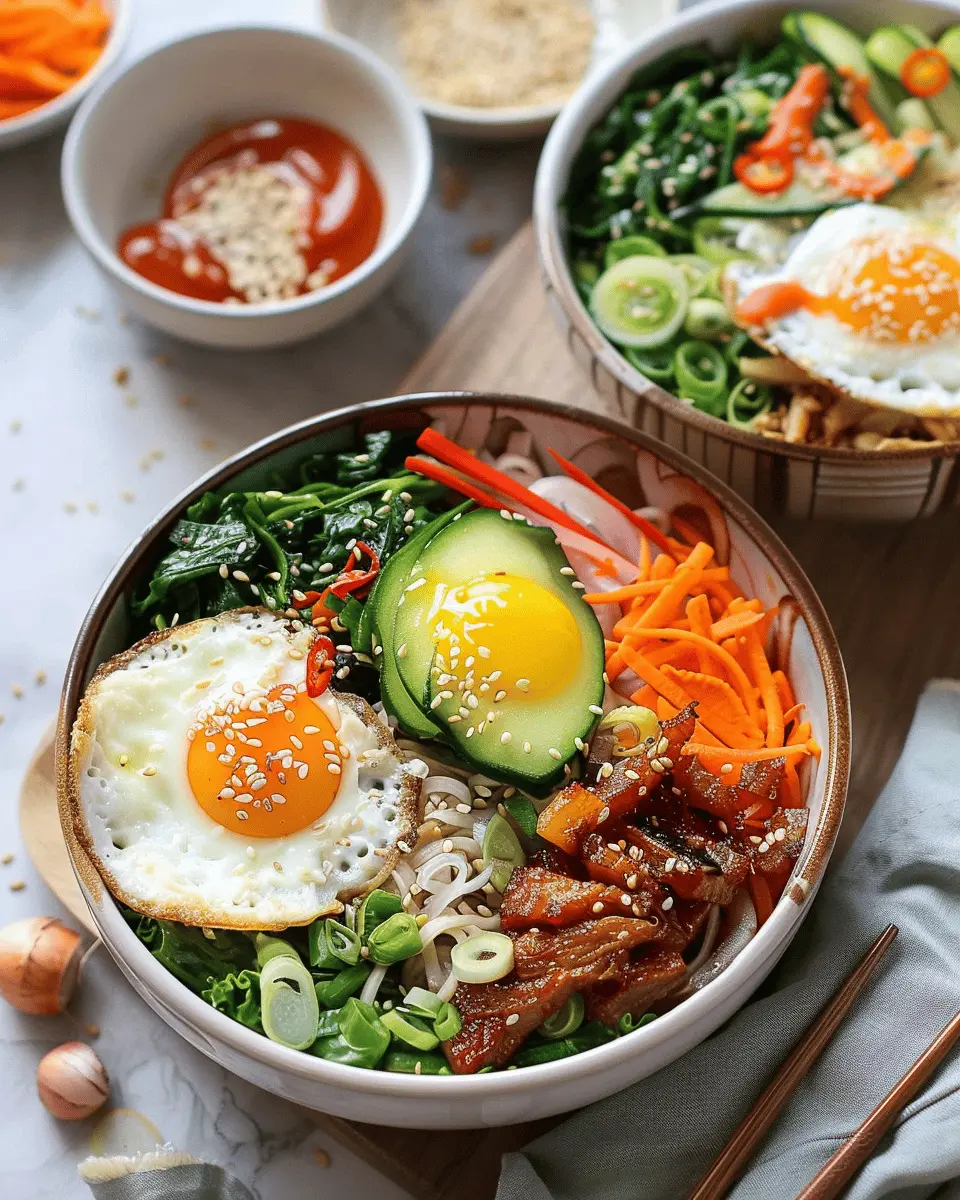Introduction to Korean Veggie Bibimbap Bowls
If you’re looking to explore the vibrant flavors of Korean cuisine, you’ve probably heard of bibimbap. This traditional dish is a beautiful amalgamation of rice, assorted vegetables, eggs, and often a splash of savory sauces, making it both a feast for the eyes and a delight for the taste buds. Bibimbap literally translates to “mixed rice,” and it’s important for good reason—it embodies the philosophy of balance and harmony found in Korean cooking.
What is Bibimbap and Its Importance in Korean Cuisine?
Bibimbap dates back to the late 19th century and is considered a staple in Korean households. It’s a dish that reflects the core values of Korean cuisine, such as seasonality, balance, and color. What makes it truly unique is the variety of ingredients used, ranging from fresh vegetables to proteins, allowing you to customize it to your liking. According to a study on Korean food culture, meals like bibimbap play a significant role in social gatherings, creating moments of togetherness that nourish both the body and spirit.
When it comes to the Korean Veggie Bibimbap Bowls, the focus shifts toward health and creativity. Utilizing a rainbow of veggies not only ensures a plethora of nutrients but also showcases the aesthetic beauty of your meal. Think sautéed spinach, zesty carrots, and crunchy cucumbers layered beautifully on a bed of warm rice. This makes it a go-to for busy young professionals looking for a quick yet satisfying lunch or dinner option.
Why Choose Veggie Bibimbap?
You might be wondering, “Why go for the veggie version?” Well, the answer lies in simplicity and flavor. Vegetable bibimbap allows the fresh ingredients to shine, and it’s easily adaptable for various dietary preferences. Whether you’re a vegetarian, trying to cut down on meat, or just looking to incorporate more greens into your diet, this dish has you covered.
So, whether you plan to make it for a dinner party or a cozy night in, Korean Veggie Bibimbap Bowls offer a delightful experience. With the right combination of ingredients and a simple preparation method, you’ll find that this cherished Korean classic quickly becomes a household favorite. Ready to dive into the recipe? Let’s get cooking!

Ingredients for Korean Veggie Bibimbap Bowls
Creating delicious Korean Veggie Bibimbap Bowls is all about selecting fresh ingredients and vibrant flavors. Here’s what you’ll need to elevate your bowl to perfection!
Fresh Vegetables and Staples
Start with seasonal vegetables to bring your bibimbap to life. Here are some must-haves:
- Spinach: Sautéed or blanched, it adds a lovely depth.
- Zucchini: Thinly sliced and lightly stir-fried for a delightful crunch.
- Carrots: Julienned or grated for a touch of sweetness.
- Mushrooms: Shiitake or button, sliced, and sautéed until tender.
- Cucumbers: Fresh and crisp, sliced for adding a refreshing note.
- Cooked Rice: Ideally short-grain, for a sticky texture.
Want to learn more about the nutritional benefits of these ingredients? Check out sources like Healthline for insights.
Essential Condiments
The magic of bibimbap lies in its toppings and sauces. Don’t skip these essentials:
- Gochujang: A Korean chili paste that adds spice and sweetness.
- Sesame oil: For a nutty flavor that ties everything together.
- Soy sauce: Just a splash enhances the overall umami.
- Sesame seeds: Toasted, they provide a wonderful crunch.
These condiments not only enhance flavors but also bring depth to your Korean Veggie Bibimbap Bowls. Curious about the best brands? Check reviews on Serious Eats for guidance!
Now that you have a solid list of ingredients, you’re well on your way to creating a satisfying and colorful meal that will impress your taste buds and your guests alike!
Preparing Korean Veggie Bibimbap Bowls
Creating Korean Veggie Bibimbap Bowls is not just a cooking task; it’s an opportunity to bring a bit of Korean culture into your kitchen. This colorful and nutritious dish is perfect for busy weeknights or whenever you’re craving something hearty yet healthy. So, let’s dive into the delightful process of preparing your Bibimbap!
Cook the Rice Perfectly
The foundation of any good Bibimbap is undoubtedly the rice. For traditional Bibimbap, short-grain rice works wonderfully due to its stickiness. Follow these straightforward steps for perfectly cooked rice:
- Rinse the Rice: Start by rinsing 1 cup of rice under cold water until the water runs clear. This removes excess starch and prevents it from being too gummy.
- Cook It Right: Combine the rinsed rice with 1.5 cups of water in a rice cooker or pot. If using a pot, bring it to a boil, then reduce to a simmer, cover, and let it cook for about 18-20 minutes. After that, keep it covered for another 10 minutes off the heat to finish steaming.
- Fluff and Set Aside: Once it’s done, fluff it with a fork and set aside to cool slightly while you prep the rest.
Ensuring your rice is cooked to perfection sets the stage for the vibrant flavors that will come next.
Sauté the Vegetables
Now comes the fun part! Sautéing the vegetables not only enhances their flavor but also adds stunning colors to your Korean Veggie Bibimbap Bowls. Here’s what you’ll need:
- Vegetables: A mix of carrots, spinach, mushrooms, zucchini, and bean sprouts works beautifully.
- Cooking Oil: Use sesame oil for that authentic flavor.
The Sautéing Process:
- Heat about 2 teaspoons of sesame oil in a skillet over medium heat.
- Add the vegetables one by one (stir-frying each for 2-3 minutes).
- Season with a bit of salt and pepper to taste.
Feel free to mix and match your favorite seasonal veggies. Did you know that adding a variety of colors can increase the nutritional value of your meal?
Fry the Eggs to Perfection
No Bibimbap is complete without a perfectly fried egg! Here’s how to achieve that golden, runny yolk that you can break over your bowl.
- Get the Pan Ready: Heat a non-stick skillet over medium-low heat and add a bit of oil.
- Fry the Eggs: Crack in one egg and cook until the whites are set but the yolk is still runny, about 2-3 minutes. For an extra touch, consider using an egg ring to keep it neatly shaped!
An egg on top not only adds protein but also makes your Korean Veggie Bibimbap Bowls visually appealing!
Assemble the Bibimbap Bowls
Now, the moment of truth! Assembling your Bibimbap is an art form. Here’s how to do it:
- Start with a serving of warm rice as your base.
- Arrange your sautéed vegetables artistically around the rice.
- Add your fried egg on top, which is the cherry on this colorful cake.
- For added texture, sprinkle some sesame seeds or chopped green onions on top.
Drizzle with Gochujang Sauce
The final touch is the Gochujang sauce, which ties everything together with its spicy and savory kick.
- Make the Sauce: In a small bowl, mix 2 tablespoons of Gochujang paste with a teaspoon of honey and a teaspoon of sesame oil. Stir until smooth.
- Drizzle and Enjoy: Drizzle this sauce over your assembled Korean Veggie Bibimbap Bowls according to your taste. The balance of savory and spicy will elevate the dish to another level!
In just a few steps, you’ve transformed simple ingredients into a satisfying, colorful meal that’s as delicious as it is beautiful. Enjoy your homemade Korean Veggie Bibimbap Bowls, and don’t forget to take a moment to appreciate the incredible array of flavors and textures you’ve created. Happy cooking!
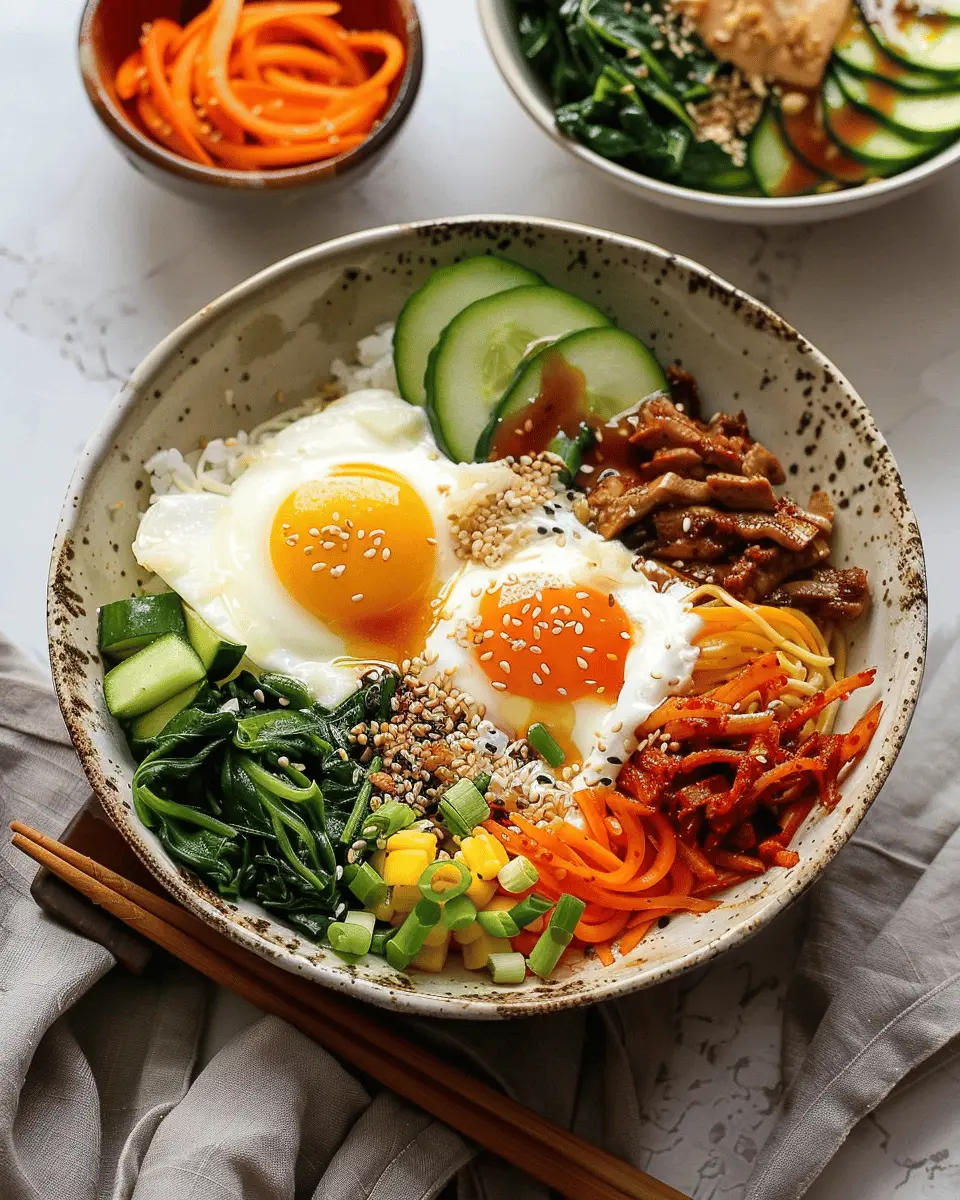
Variations on Korean Veggie Bibimbap Bowls
Creating your own Korean Veggie Bibimbap Bowls is not only easy but also a delightful way to experiment with different ingredients. Let’s dive into some creative variations that can elevate your dish!
Add More Proteins
While traditional bibimbap often features an egg on top, you can easily up the protein content to suit your dietary preferences or needs. Consider these delicious options:
- Chicken Ham: Adds a savory and slightly smoky flavor.
- Turkey Bacon: Offers crispiness and a unique taste that complements the veggies beautifully.
- Tofu: For a plant-based option, marinated grilled tofu can provide a meaty texture and absorb the flavors of the sauce well.
- Edamame: These little green gems pack a protein punch and are easy to toss in.
Adding a variety of proteins not only enhances nutrition but also makes for a filling meal that keeps you satisfied (and happy!).
Experiment with Different Vegetables
The beauty of Korean Veggie Bibimbap Bowls lies in their versatility. Feel free to get creative with your vegetable mix! Here are some ideas to inspire your next bowl:
- Zucchini: Thinly sliced and sautéed, it adds a refreshing crunch.
- Korean Radish (Mu): For a bit of tang, this can be pickled or cooked.
- Bell Peppers: Colorful and sweet, they can brighten up your bowl both visually and flavor-wise.
- Spinach or Kale: Leafy greens add nutrients along with a lovely texture when wilted.
The combination of colors and flavors makes each bibimbap unique and even more enticing.
For inspiration, check out Korean Culinary Culture to explore traditional and modern takes on this iconic dish. You’ll never run out of ideas when it comes to creating your personalized bibimbap experience!
Cooking Tips and Notes for Korean Veggie Bibimbap Bowls
Perfecting the Gochujang Sauce
The Gochujang sauce is what gives your Korean Veggie Bibimbap Bowls that unmistakable flavor kick. To get it just right:
- Balance the Flavors: Combine Gochujang with a splash of sesame oil, a dollop of honey or maple syrup for sweetness, and a bit of soy sauce for umami.
- Adjust to Your Heat Preference: Feel free to start with a smaller amount of Gochujang, then gradually increase it until you hit your desired spice level.
Rice Cooking Tips
The rice is the heart of any great bibimbap! For perfectly cooked rice:
- Rinse Thoroughly: Rinsing your rice until the water runs clear helps to remove excess starch, resulting in fluffier grains.
- Use the Right Rice: Employ short-grain or medium-grain Korean rice for the best texture, as it tends to be stickier, making it easier to eat with chopsticks.
- Water Ratio: A common ratio is 1:1.2 of rice to water; feel free to adjust if you like your rice softer or firmer.
Enjoy the delightful blend of flavors and textures in your Korean Veggie Bibimbap Bowls! For more tips, check out resources from Korean Bapsang and the Korean Food Foundation.

Serving suggestions for Korean Veggie Bibimbap Bowls
Bowl Pairings and Accompaniments
When it comes to enhancing your Korean Veggie Bibimbap Bowls, consider varied bowl pairings and accompaniments that elevate your meal experience. Try serving your bibimbap with:
- Kimchi: This classic fermented side will add an exciting zing and loads of probiotics to aid digestion.
- Fried Tofu: A protein-packed alternative, crispy fried tofu will complement the textures in your bowl beautifully.
- Sesame Seed Garnish: Sprinkle some toasted sesame seeds over the top for a nutty finish that ties everything together.
For a refreshing drink, why not enjoy a glass of cold barley tea? It complements the savory flavors of bibimbap perfectly and is a traditional Korean beverage.
Creative Serving Styles
Serving your Korean Veggie Bibimbap Bowls can be as creative as you want! Consider these fun ideas:
- Layered Presentation: Arrange the components in separate sections for a stunning visual that invites your guests (or yourself!) to mix.
- Bento Style: Serve your bibimbap in a bento box along with small portions of pickled vegetables or side salads. Not only is it aesthetically pleasing, but it also allows for a variety of flavors in each bite.
- DIY Station: For gatherings, set up a DIY bibimbap station. This encourages everyone to customize their bowl, making it interactive and fun.
No matter how you choose to serve it, your Korean Veggie Bibimbap Bowls are sure to impress!
Time breakdown for Korean Veggie Bibimbap Bowls
Preparation time
Getting your Korean Veggie Bibimbap Bowls ready is a breeze! You’ll want to set aside about 20 minutes for chopping veggies and marinating your proteins. This is the fun part where you can let your creativity shine.
Cooking time
Once everything’s prepped, the cooking time will be around 15-20 minutes. You’ll be stir-frying those vibrant veggies and cooking your rice to perfection. It’s quick and satisfying!
Total time
In total, you’re looking at roughly 35-40 minutes from start to finish. Perfect for busy weeknights when you crave something healthy yet delicious! If you’re curious about more ways to make meal prep easier, check out resources like Meal Prep on Fleek for tips. Enjoy your cooking journey!
Nutritional facts for Korean Veggie Bibimbap Bowls
Looking to indulge in a flavorful dish that won’t derail your healthy eating goals? Korean Veggie Bibimbap Bowls offer a wholesome balance of nutrients.
Calories
A generous serving of these vibrant bowls typically contains around 450–500 calories, depending on the specific veggies and toppings you choose. It’s a satisfying meal that can fuel your day without leaving you feeling sluggish.
Macronutrients
These bowls are not just about good taste; they pack a nutritional punch as well. You can expect approximately:
- Carbohydrates: 60 grams (mainly from rice and veggies)
- Protein: 12 grams (thanks to tofu or lean chicken)
- Fats: 15 grams (mostly healthy fats from sesame oil and avocado)
Each ingredient contributes to a well-rounded meal, offering fiber, vitamins, and minerals. For more guidance on healthy eating, consider visiting the Harvard T.H. Chan School of Public Health. Wouldn’t it be great to mix flavors and health in one bowl?
FAQs about Korean Veggie Bibimbap Bowls
Can I make bibimbap vegan?
Absolutely! Making Korean Veggie Bibimbap Bowls vegan is a breeze. Simply replace any animal-based proteins with plant-based options. Tofu is a fantastic substitute—try marinating it in soy sauce or gochujang for extra flavor. You can enhance your dish with a variety of veggies like mushrooms, spinach, and carrots. For creaminess, top it with avocado or a dollop of sesame oil. If you’re looking for more vegan inspiration, check out this plant-based bibimbap recipe.
What rice is best for bibimbap?
When it comes to Korean Veggie Bibimbap Bowls, short-grain rice is typically the star. Its sticky texture helps keep all those vibrant ingredients together. If you’re feeling adventurous, brown rice provides a nuttier flavor and extra nutrients. There’s no need to stress—both types work wonderfully and cater to different dietary needs. Plus, they help create that delightful contrast with the colorful veggies, enhancing the visual appeal of your dish.
How to store leftovers properly?
Leftovers from your Korean Veggie Bibimbap Bowls can be a quick, delicious lunch option. Store any uneaten portions in an airtight container in the fridge for up to three days. When you’re ready to enjoy them again, just reheat in the microwave. If you’ve topped your bibimbap with a fried egg, consider cooking a fresh one when it’s time to serve. This way, you can savor that delightful runny yolk with each bite! For more tips on food storage, visit FoodSafety.gov.
Conclusion on Korean Veggie Bibimbap Bowls
Emphasizing the Joy of Homemade Meals
Crafting your own Korean Veggie Bibimbap Bowls isn’t just about the flavors—it’s about the experience. Preparing a vibrant bowl filled with fresh ingredients evokes a sense of creativity and accomplishment. As you layer the colorful vegetables, aromatic sesame oil, and protein-rich toppings, you’re not just making food; you’re piecing together a delightful culinary adventure that connects you to the rich culture of Korea.
Plus, sharing these flavors with friends can turn any ordinary evening into a memorable feast. So why not gather your favorite people, whip up this easy dish, and enjoy the warmth of homemade meals together? Dive into the world of Korean Veggie Bibimbap Bowls and savor every bite! For additional inspiration, consider exploring this resource on Korean cuisine to expand your culinary journey.
PrintKorean Veggie Bibimbap Bowls: A Flavorful Twist on Healthy Eating
A delicious and healthy bibimbap bowl packed with vibrant veggies and flavors that brings a Korean twist to your meal.
- Prep Time: 15 minutes
- Cook Time: 15 minutes
- Total Time: 30 minutes
- Yield: 2 servings 1x
- Category: Main Dish
- Method: Stovetop
- Cuisine: Korean
- Diet: Vegetarian
Ingredients
- 1 cup cooked rice
- 1 cup spinach, sautéed
- 1 cup carrots, julienned
- 1 cup cucumber, sliced
- 1/2 cup mushrooms, sautéed
- 1 egg, fried or poached
- 2 tbsp gochujang sauce
- 1 tbsp sesame oil
- 1 tbsp sesame seeds
Instructions
- Start by cooking the rice according to package instructions.
- While the rice cooks, prepare the vegetables by sautéing the spinach and mushrooms.
- Julienne the carrots and slice the cucumber.
- Once the rice is ready, assemble the bowls by placing rice at the bottom.
- Top with sautéed spinach, carrots, cucumbers, and mushrooms.
- Add a fried or poached egg on top.
- Drizzle with gochujang sauce and sesame oil.
- Sprinkle sesame seeds for garnish.
- Mix well before serving to enjoy the flavors.
Notes
- For a vegetarian version, omit the egg or substitute with tofu.
- Add your choice of protein, like grilled chicken or beef, if desired.
Nutrition
- Serving Size: 1 bowl
- Calories: 450
- Sugar: 3g
- Sodium: 600mg
- Fat: 20g
- Saturated Fat: 3g
- Unsaturated Fat: 10g
- Trans Fat: 0g
- Carbohydrates: 60g
- Fiber: 5g
- Protein: 12g
- Cholesterol: 186mg
Keywords: Korean, Veggie, Bibimbap, Healthy, Bowls
